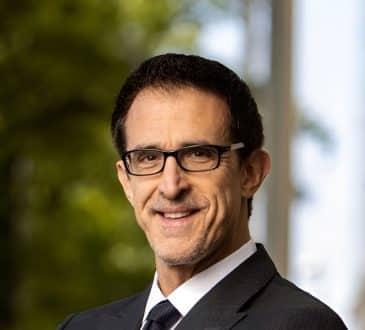Meaningful change requires buy-in. Here’s how to get your organization on board.

Once we have a new business solution worthy of committing a decent chunk of our lives to, we soon realize that the world has rarely been waiting for us to implement it. In fact, most people beyond our core team will resist or reject the unfamiliar in an instant. We have to cut through the noise, chaos, and ambivalence with a compelling and well-crafted vision.
Once we have a potentially transformational idea, innovation, or strategy to future-proof a part of our organization—from a more fitting expenses policy to a billion-dollar business model—we have to get everyone else in the organization and beyond to understand it, buy into it, find their role to play in implementing it, and work together to deliver it. Then we have to get our customer base and stakeholders to use it and pay for it. This is where the skills and qualities of inspirational and influential leadership will help us not just have a bold breakthrough, but actually manifest it in a world that is generally resistant.
No amount of genius in our ideas and plans will mean a jot if we can’t capture the hearts and mind of others to get them behind our ideas. Many leaders win the war but lose the peace. Given that manipulative and coercive ways of getting people to support us—through explicit threats of censure, veiled threats of sanctions, or through bribes and promotions—are less effective than ever, we actually have to inspire and influence people to change. We must find ways ethically to get groups of people to change their protective patterns which are often developed over a lifetime and working for them just fine (or so they think).
Story is the essential tool for inspiring and influencing others ethically. Narratives of the future that show how things could be (and why), and that paint a navigational pathway for manifesting possibility. Stories, whether brand commercials or quick emails to the company, can drive mass behavior change in hands. To ensure that happens, they give the head rational and logical reasons to change. But people will not pay attention, care about a solution, or be able to overcome their fears of change until the emotional heart has been captivated.
Transformational narratives that capture hearts and shift mindsets have a call to action designed to deliver the change in behaviors necessary for the transformation we envision. Stories are our species’ solution for how to transform others without coercion. Otherwise we will fail to overcome the Backfire Effect: the more we try to challenge a strongly held belief rooted in emotions with reason, evidence, and facts, the more believers believe they are right. They double down on their erroneous assumptions.
I see storytelling as two separate yet related activities. The first is story-crafting: designing a narrative that meets our audience where they are at and then takes them somewhere higher, better. We painstakingly craft a story that includes all the key ingredients that hara, heart, head, and hands need to effect the various changes we want to see that will scale up to transformation.
After that, the second element is story-sharing: how we deliver that story in pitches, talks, brand identities, landing pages, meetings, emails, reports, pitch decks, social media posts, commercials, and more.
Transformational leaders must become consummate experts at both skills, while always being aware that a powerful protective pattern is to leverage stories for the wrong reason: to obfuscate, gain affection, and capture attention without a purpose-driven vision.
Story-crafting requires that we can first envision an alternative, valuable, and achievable future to the one predicated by extrapolating trends from past: a transformed reality that is markedly different from the one that is likely to occur without transformational leadership.
We must be able to craft this possible future within a “transformational vision” that feels both new and refreshing yet also attainable and familiar. If it is too other-worldly, many people will connect with it or see themselves in it. If it is too mundane and banal, there is no transformation and there is little value in us holding the vision.
The vision should, of course, come from a strategic and systematic interrogation of the future and be driven by real and profound insight into existing and future customers’/users’/employees’ needs, wants, and yearnings. But it must also be relatively simple, even if we know that simplicity is an artificial construct in a VUCA world.
Finding appropriate ways to communicate transformational ideas and insights is key and often our signal is drowned out by noise, the complaints of protective patterns, the plethora of internal comms, corporate jargon established by the legacy business model, and cultural codes and team shortcuts that obfuscate as much as clarify. We must then be able to turn a vision of how the future could be into a compelling and coherent narrative structure that inspires others to get involved.
Every story structure requires, at minimum:
- Essential context that explains why the transformational idea or strategy is better than the past and why it is the right fit for this organization to bring to life right now
- Clarity of focus and intent, reducing complexity and noise in the system so people of varying levels of cognitive-behavioral complexity and embodied wisdom can see their role and where best to act
- A call-to-action, which explicitly asks people to change their behavior, whether through shifting the allocation of resources or through speaking or acting in a new way.
Once we have developed a story with the right elements and ingredients—perhaps with multiple variants for different audience segments—we then must decide how, when, and with whom to share the story. Whilst some of our communication efforts will be through media, like video and reports, we will at some point have to share our story in person.
This means mastering how to show up with our full potential as inspirational transformational leaders: how best to speak about, and present, ideas that fit our character and how to be fully present ourselves with people, at ease in our skins. The transformational leader knows never to moan that investors don’t get our genius idea, customers don’t get how awesome our product is, or bosses don’t appreciate our brilliance. Instead we own the resistance and refusals and metabolize them into a more compelling vision, a clearer and more engaging narrative, and more executive presence.
Have you read?
World’s Best Places To Visit.
Best Wedding Destinations in The Caribbean.
Oldest hotels in the United States.
Best Family Vacation Destinations In The US.
Bring the best of the CEOWORLD magazine's global journalism to audiences in the United States and around the world. - Add CEOWORLD magazine to your Google News feed.
Follow CEOWORLD magazine headlines on: Google News, LinkedIn, Twitter, and Facebook.
Copyright 2025 The CEOWORLD magazine. All rights reserved. This material (and any extract from it) must not be copied, redistributed or placed on any website, without CEOWORLD magazine' prior written consent. For media queries, please contact: info@ceoworld.biz








